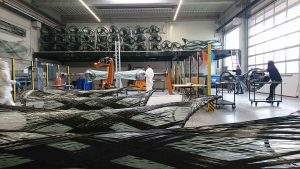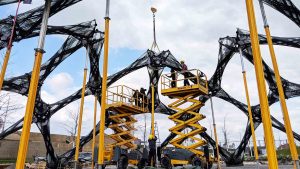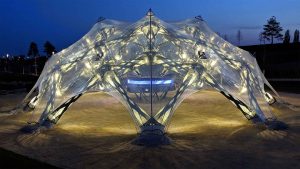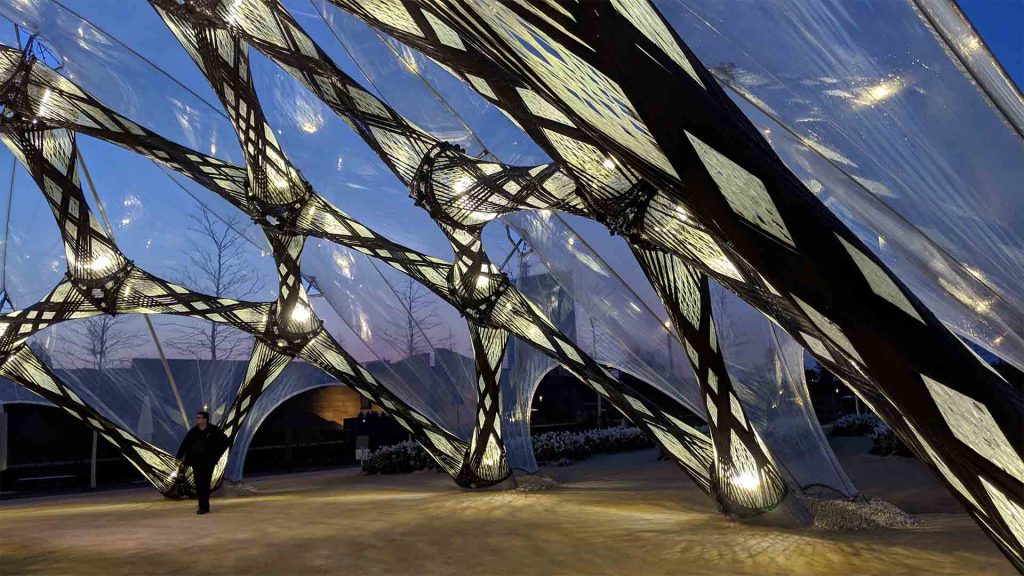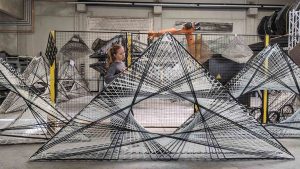
Material Computation and Robotic Fabrication: A Conversation with Moritz Dörstelmann
Moritz Dörstelmann is Managing Partner of FibR, a specialist company for computational design and robotic fabrication of bespoke filament structures and guest researcher at the Technical University of Munich. Moritz works are design driven and technology based projects, enabling the exploration of a novel design and construction repertoire. His works have been widely published and exhibited internationally.
After studying first at the at RWTH Aachen University and the graduating with distinction from the the master class of Zaha Hadid and Patrik Schumacher at the University of Applied Arts in Vienna, he joined the Institute for Computational Design and Construction (ICD) at the University of Stuttgart, teaching and developing research in the field of integrated design and fabrication methods for novel fiber composites structures.
He realized a series of experimental pavilions, showcasing the architectural potential of novel fiber composite lightweight structures. He is lecturer and teaching fellow at various international institutions, his projects received several awards including the German Design Award 2020, Iconic Awards 2019 for Innovative Architecture and many others.
This month, we connected with Moritz Dörstelmann to talk about his work and his extraordinary projects and learn more about robotic fabrication and lightweight structures and the innovative technology developed by FibR. Unpacking Data in Practice is Data Aided Design’s recurring series highlighting emerging design professionals as they share their thoughts and perspectives on data-driven design.
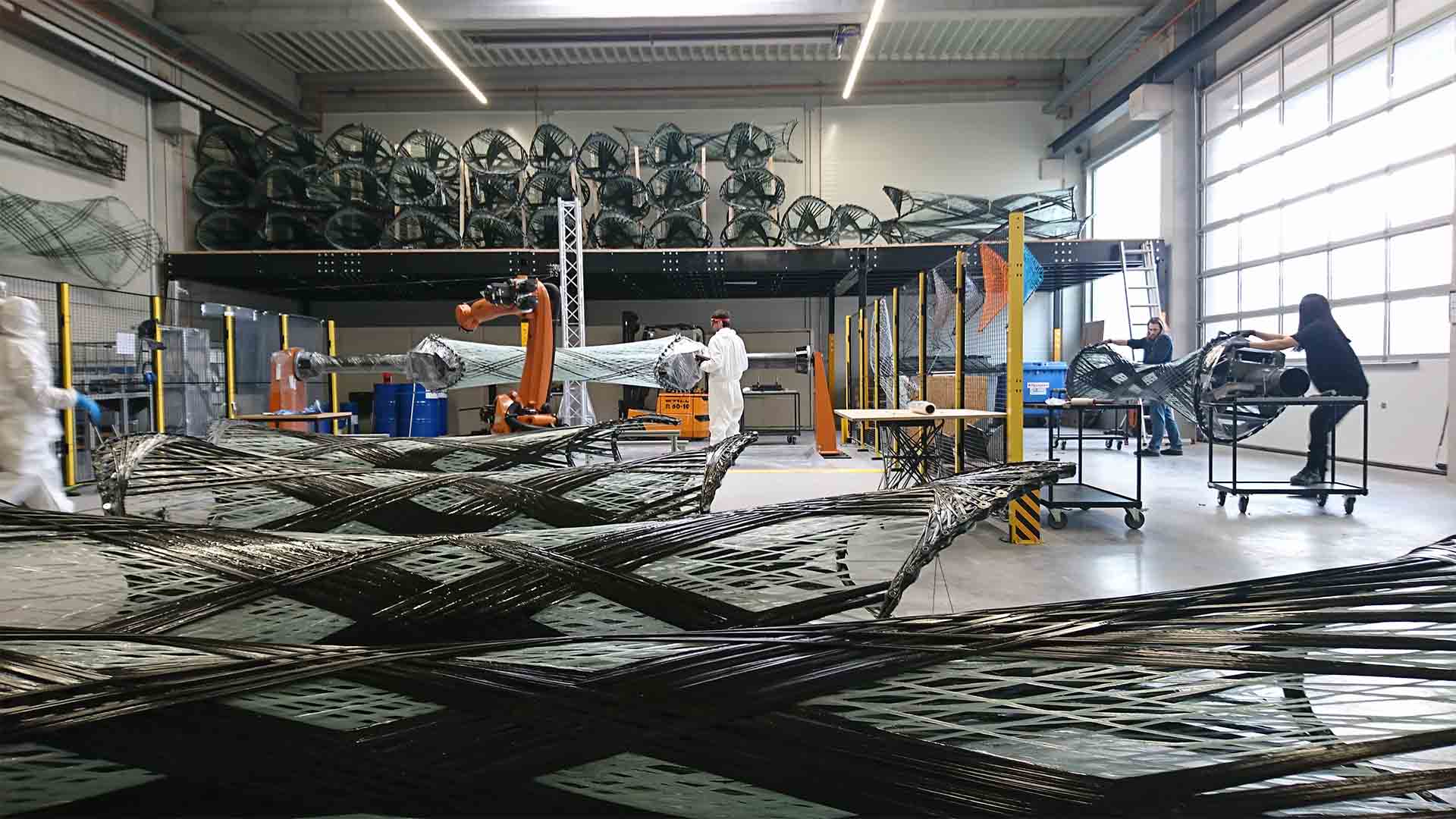
After several years of research and work at Institute for Computational Design and Construction (ICD) at the University of Stuttgart you are now Managing Partner at FibR (www.fibr.tech), could you introduce us to the challenges and the opportunities related to the implementation of digital fabrication in the construction industry and explain the impact you expect it to have on society?
The preservation of our world’s livelihood through environmentally and economically sustainable ways of life is the central challenge of our times. The architectural profession is deeply involved in most of today’s societal mega topics and the building industry accounts for large parts of humankind’s resource consumption. Thus the societal challenges of today are closely interdependent with the building sectors main challenges to produce living and working space at an ever growing pace with growing quality requirements in a sustainable way. Integrative digital design and fabrication methods hold the promise to deliver tailor made building components with reduced environmental impact. This novel degree of resource efficiency can unfold on three different levels.First through material efficient design which anticipates the opportunities of locally differentiated high resolution fabrication methods and utilizes those for tailored structural properties and thus minimal material usage to meet the desired structural performance. Secondly through material efficiency in the production process, which can be achieved through circular economy models which are enabled by digital fabrication technology, such as waste free additive fabrication, or subtractive methods where cutoff material is fed back into the production cycle. Third, the individualized production of adapted building systems also allows for a better contextualization to local climate conditions and allows for a higher degree of functional integration.
Challenges arising along that way include mostly legislation and economic boundary conditions. Time will show how fast ecologic pressure will turn into economic pressure and give resource efficient constructions a monetary edge. Hopefully, this process can unfold in a market setting where politicians do not promote specific technologies but rather define the boundary conditions and aims for an open race towards the best technologies and their entrepreneurial implementations.
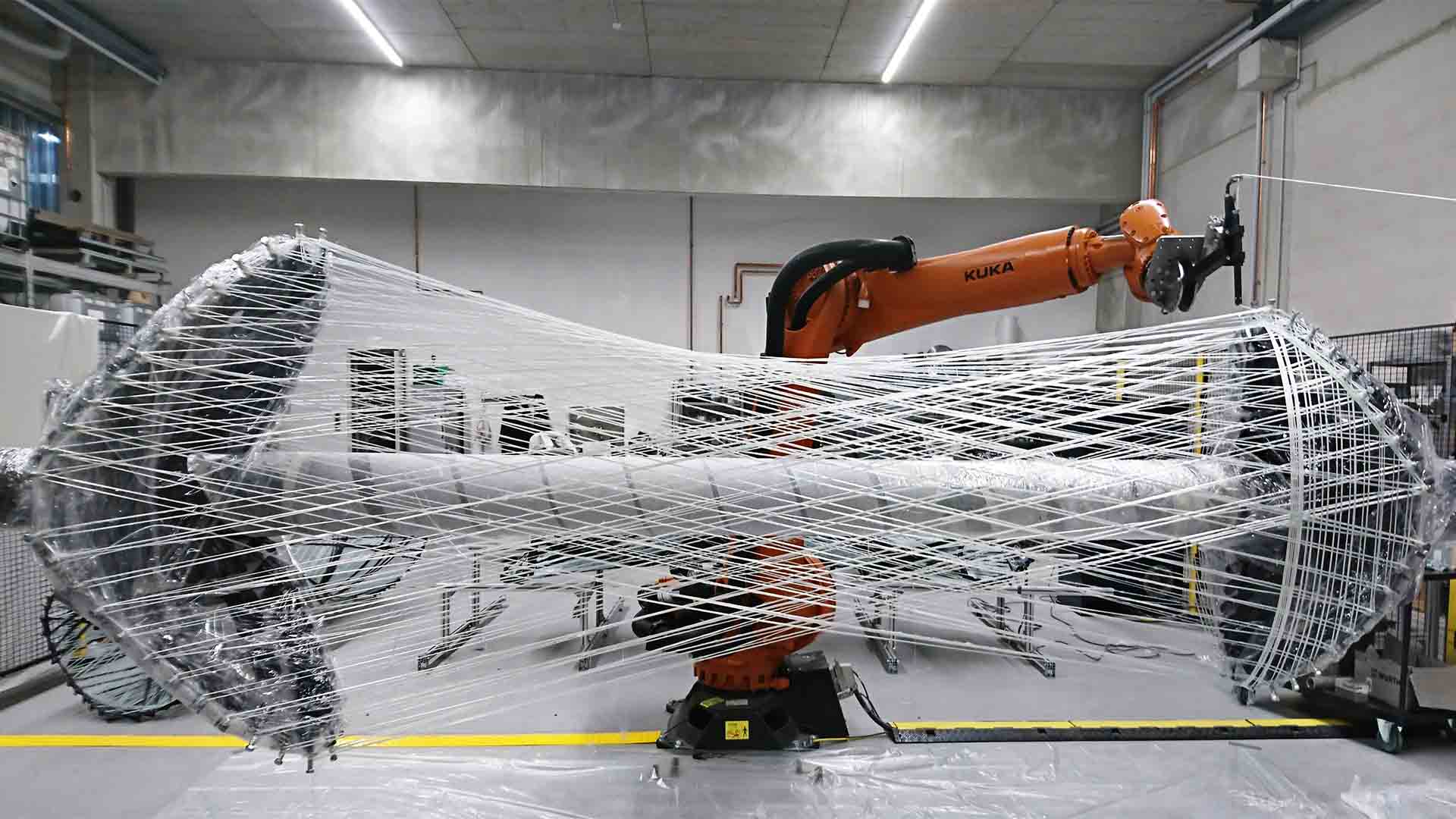
In your company FibR you work with advanced digital Fabrication technologies based on the use of robots, innovative materials and algorithms, can you introduce us to your technology and your workflow?
FibR is a construction company offering computational design and robotic fabrication of bespoke fiber composite structures. We enable the exploration of a novel design and construction repertoire for expressive high-performance lightweight structures. Applications include load bearing structures, facades, interiors and furniture. At the core of our construction process is the computational arrangement and robotic placement of fibers to form bespoke building components. Similar to natural load bearing structures, such as beetle shells from chitin fibers, animal tissues from collagen fibers, or plants from cellulose fibers, we are utilizing the anisotropic properties of technical fiber composite materials to locally tailor the performance and visual appearance of our construction components. Our spatial winding procedure utilizes the flexible programming of industrial robots to place fiber bundles around precisely positioned winding pins in a particular sequencing, such that those fibers interact in space and form a component geometry which is emerging through the fiber interaction and is not inscribed in the formwork. This allows for larger flexibility to vary fiber orientation, density, and component geometry just by changing the robot code. This high-resolution variation per piece allows for the production of unique building components.The procedure is very material efficient on multiple levels. First, it enables the design and fabrication of high performance ultra-lightweight components which drastically reduces the embodied energy and emissions in construction. Secondly the additive and selective placement of anisotropic materials happens in a nearly waste free process. Third, a reduced tooling effort can be achieved by shifting geometry information for the hardware into the robot code and allows for larger variation of parts. Construction technological advancements have always been accompanied by an exploration of its novel inherent architectural design and construction repertoire. In this sense our digital lightweight construction technology not only allows for incredibly light yet performant construction parts, but also explores a novel material and process specific design repertoire. We offer our vertically integrated services across all project phases. Depending on project requirements and client demands we offer design services as well as construction services, covering a broad range of expertise from concept development, design and construction detailing to certification of our building components, robotic production and on-site installation of fiber composite structures.
The architectural background part of our team expertise enables an integrative design process in close cooperation with architects and designers. We realize smaller scale composite structures as general contractors from concept development to installation on site. In this scenario we subcontract structural design, fire engineering and climate design as well as other construction trades such as façade construction, steelworks and foundations. Most projects are developed in classical teams where we are usually either subcontracted by the architects or have a separate design assist contract with the client in early design stages. The subsequent detail development phase is accompanied by physical prototypes and digital/physical development iterations, which form a very useful tool to tailor the outcome towards the desired design intent and performance goals. Over the last years we developed an inhouse expertise for the certification of our non-standardized construction technology. This enables us to conduct destructive 1:1 scale load bearing tests on our heavy duty test setup and allows for fast digital / physical structural design and construction detailing iterations. After the project specific development and certification process the robotic production follows a less flexible regime in which quality assurance and documentation processes predominate. This part is enabled through sensor integrated processes which allow for seamless documentation of the fabrication process. The installation of our light and precise prefabricated components showcases a minimal invasive building site, which is not characterized by the usual associations with noise, dirt and heavy machinery but showcases a model for fast, clean and precise construction processes.
In 2019 you completed the BUGA Fiber Pavilion in collaboration with ICD and ITKE at the University of Stuttgart, could you talk about this project, the vision behind it and the main challenges and technological achievements that you encountered during this project?
The Buga fiber pavilion marked an important step in the transition of our digital lightweight construction technology from academia into architectural practice. It is one of the first load bearing structures realized by our company and follows a series of academic precedent works developed at the University of Stuttgart where parts of our team and myself were involved in the exploration and development of robotically fabricated fibrous lightweight structures in architecture. The project was realized in the context of the federal gardening show (Buga) 2019 in Heilbronn. The Buga Heilbronn linked important urban design developments in the city together with a showcase in construction innovation and a classical gardening show. The Buga Fiber Pavilion is one of two experimental architectural structures which combine the natural topic of a gardening show with the local high-tech context in Baden Wurttemberg. The Buga Fiber Pavilion spans 23m, covers 400m², is 7m high and weights only around 7.5kg/m² as an ultra-light load bearing structure. Its longest construction component is nearly 6m long and can easily be carried by two people. The modular structure is mobile and planned to be relocated within its lifespan.


